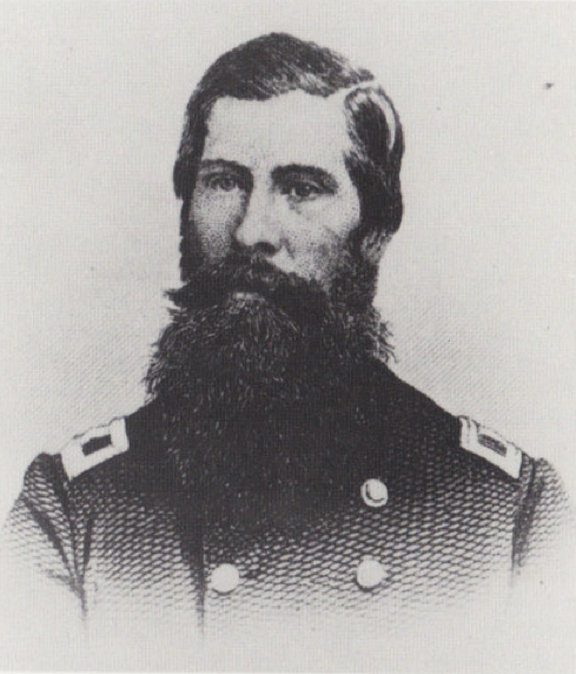Col. John McLane of the 83rd Pennsylvania Volunteer Infantry at Gaines Mill

Photo Credit: https://taps150.org
In 1859 John W. McLane formed and commanded a mostly ceremonial militia unit in Erie, Pennsylvania, known as the Wayne Guard. When war broke out in April of 1861, McLane, now a colonel, put out a call for volunteers. Within days twelve hundred men had volunteered. Pennsylvania Governor Andrew G. Curtin accepted into service ten companies of seventy men each, who became known as the Erie Regiment.
When their 90-day term of service expired in July, having only gotten as far as Pittsburgh, McLane formed a new regiment, this time for three years’ service. In September 1861 they were mustered into service as the 83rd Pennsylvania Volunteers.
Arriving in Washington D.C. on September 20, 1861, the 83rd spent the rest of 1861, and into the Spring on 1862 in camp, first at Meridian Hill, the Hall’s Hill, where they were placed in Brigadier General Daniel Butterfield’s 3rd Brigade of Major General Fritz-John Porter’s 3rd Division of the then Union III Corps[1].
The 83rd landed at Hampton, Virginia on March 25, and two days later began working their way up the Peninsula toward Big Bethel, and by April 5th, they were near Yorktown. On May 7th they boarded transports and, on the 9th, landed at White House, on the Pamunkey River.
On May 18th, Major General George B. McClellan created the V Corps of the Union Army within the Army of the Potomac, naming Porter commander of it and transferring his 3rd Division to it, making it the 1st Division of the V Corps, under Brigadier General George W. Morell, with the brigade still under Gen. Butterfield.
On May 27th the 83rd fought at Hanover Court House, its first engagement, and fought well. They advanced through the woods between the railroad cut and the Hanover Road, almost to the railway station, driving the enemy before them after a brisk exchange of gunfire. Afterwards, they marched down the rail line to participate in the fighting near the Ashland Road. On May 29th they returned to their camp near Cold Harbor.
The Union V Corps, being the only corps of the army on the north side of the Chickahominy, unanchored and open to attack. On June 26th McClellan ordered the V Corps to pull back to near Cold Harbor and Gaines’ Mill, in preparation to changing the army’s base of operation to the James River, a move planned for the next day, June 27th.
General Butterfield formed his brigade on the far left of the V Corps line on June 27th, along an area knows as Boatsman Swamp. The 44th New York and the 83rd Pennsylvania making up the first rank, the 16th Michigan and 12th New York, the second. The front rank hastily constructed a breastwork of logs near the bottom of the hill, and the second rank took up position part way up the hill.
By mid-afternoon heavy skirmishing finally broke out in front of the brigade, as three brigades from Major General James Longstreet’s Division advanced towards the Union left. The confederate troops had to move down the hill, cross the swamp, through the woods, and attempt to come up the other side to get close enough to effectively engage the 3rd Brigade, all while under fire from artillery and small arms.
After three attacks having been repulsed, around 7 p.m., the Confederate army launched its final attack of the battle, with three divisions, overlapping the entire V Corps line. The 1st Brigade, in position to the right of Butterfield’s men, finally broke. The 83rd found itself taking fire from its front, and right flank. McLane ordered the regiment to face about and at the double-quick form a line of battle perpendicular to their original position. Now out in the open, almost immediately, the rebels were upon them, and the regiment came under heavy fire.
Colonel McLane was shot in the right side of his chest and hit by a shell fragment above his left eye and fell with saying a word. At almost the exact same moment, Major Louis Nahgel, the temporary second in command, as Colonel Strong Vincent was hospitalized with Chickahominy Fever, was mortally wounded, among the wounded were many of the senior captains, including Captain Hiram Brown, who later went on to command the 145th Pennsylvania.[2]
Eventually, the remaining members of the 83rd made their way back to their original position, alongside the 44th New York, and continued the fight. As dark fell upon the battlefield, the 44th, and 83rd realized that they had no choice by to retreat. The men of the 83rd scattered and made their way for the river. Of the 550 men who began the battle, the regiment suffered 265 killed, wounded, or captured.[3]
In his official report, Lieutenant Colonel James C. Rice of the 44th New York wrote, that McLane, “gallantly fell at the head of his regiment, the noblest solider of us all – fell honored, loved, mourned by us all.”[4]
Sources
[1] Amos Judson, History of the Eighty-Third Regiment Pennsylvania Volunteers. (Dayton: Morningside, 1986) 19
[2] Michael Schellhammer, The 83rd Pennsylvania Volunteers in the Civil War (Jefferson: McFarland, 2003) 94
[3] Amos Judson, History of the Eighty-Third Regiment Pennsylvania Volunteers. (Dayton: Morningside, 1986) 69
[4] OR 11, pt. 2, 339
My ancestor, Hiram Arters, served in the 83rd Regiment under Col. McLane. He wrote a letter to his wife a few days before departing with his unit to Pittsburgh. Later, in 1889, he lost his life when he fell 48 feet from an oil tower at Tiona, PA.